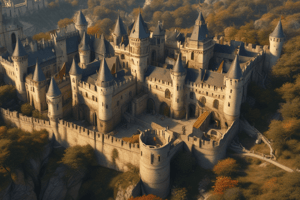Podcast
Questions and Answers
What was the primary purpose of the thick, high walls in a medieval castle's architecture?
What was the primary purpose of the thick, high walls in a medieval castle's architecture?
To protect against invaders
What was the function of the curtain walls in a medieval castle's architecture?
What was the function of the curtain walls in a medieval castle's architecture?
To provide an outer layer of defense with battlements and towers
What was the purpose of the towers in a medieval castle's architecture?
What was the purpose of the towers in a medieval castle's architecture?
For defense, observation, and as a last line of defense
What was the primary function of the gatehouses in a medieval castle's architecture?
What was the primary function of the gatehouses in a medieval castle's architecture?
What was the purpose of moats in a medieval castle's architecture?
What was the purpose of moats in a medieval castle's architecture?
What was the primary function of siege engines in medieval siege warfare?
What was the primary function of siege engines in medieval siege warfare?
What was the purpose of battering rams in medieval siege warfare?
What was the purpose of battering rams in medieval siege warfare?
What was the purpose of mining and sapping in medieval siege warfare?
What was the purpose of mining and sapping in medieval siege warfare?
What was the strategy behind blockades and starvation in medieval siege warfare?
What was the strategy behind blockades and starvation in medieval siege warfare?
Flashcards are hidden until you start studying
Study Notes
Architecture
- Walls and Curtain Walls:
- Thick, high walls (up to 10 feet thick) to protect against invaders
- Curtain walls: outer walls that surrounded the castle, often with battlements and towers
- Towers and Gatehouses:
- Towers: used for defense, observation, and as a last line of defense
- Gatehouses: heavily fortified entrances, often with portcullises and murder holes
- Moats and Water Defenses:
- Moats: water-filled ditches surrounding the castle, making it difficult to approach
- Water defenses: including flooded moats, water-filled ditches, and rivers
- Keep and Bailey:
- Keep: a strong, self-contained tower that served as a last line of defense
- Bailey: an open area inside the castle walls, used for training, recreation, and mustering troops
Siege Warfare
- Siege Engines:
- Catapults: used to launch heavy projectiles, such as rocks or fireballs
- Trebuchets: larger, more powerful catapults, often used to breach walls
- Mangonels: smaller, more portable catapults
- Battering Rams:
- Used to break down gates and walls
- Often protected by shields or mantlets to protect the attackers
- Mining and Sapping:
- Tunneling under the castle walls to collapse or breach them
- Sapping: digging trenches or tunnels to approach the castle undetected
- Blockades and Starvation:
- Surrounding the castle to cut off supplies and starve the defenders
- Used to weaken the defenders and force surrender
Studying That Suits You
Use AI to generate personalized quizzes and flashcards to suit your learning preferences.




